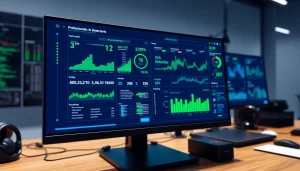Top 10 Business Trends Shaping the Future of Industry

Understanding Business Trends
Defining Business Trends
Business trends are defined as the general direction in which a business landscape is moving. These trends could be driven by consumer preferences, technological advancements, regulation changes, or economic developments. By analyzing data from various sectors, businesses can identify patterns that suggest emerging trends, enabling them to pivot their strategies accordingly. The ability to recognize and adapt to these trends distinguishes successful companies from those that struggle. While some trends are fleeting, others can reshape industries and influence operational models extensively. For instance, the shift toward e-commerce over the last decade has drastically altered how businesses engage with customers and how they operate. Therefore, understanding business trends is essential for long-term planning and success.
Importance of Tracking Business Trends
Tracking business trends is crucial for several reasons. Firstly, it allows organizations to anticipate market shifts and align their strategies accordingly, ensuring they remain competitive. Secondly, understanding trends can aid in resource allocation and talent management. For example, if an organization sees a growing trend in digital marketing, it may choose to upskill its workforce in this area or hire new talent proficient in digital strategies.
Furthermore, keeping an eye on trends helps businesses mitigate risks associated with changing consumer behaviors and preferences. As companies can launch products or services in line with market demand, tracking trends enhances customer satisfaction and loyalty. Ultimately, staying informed can lead to increased profitability and market share.
Differentiating Between Trends and Fads
While discussing business trends, it’s vital to distinguish between trends and fads. Trends represent long-term shifts in consumer behavior or market conditions, often influenced by demographic changes or technological advancements. In contrast, fads are fleeting phenomena that capture popular interest for a short duration before fading away.
A classic example distinguishing the two is the rise of social media platforms, which is a long-term trend that’s evolved over years and has permanent implications on marketing and communication. Conversely, platforms like MySpace were once trendy but have largely disappeared as consumer preferences shifted. Understanding this difference allows businesses to focus their efforts on sustainable strategies rather than chasing temporary trends, which can drain resources and misalign with their core objectives.
Key Business Trends for 2025
Rise of Generative AI in Business
The integration of generative AI into business practices is poised to revolutionize multiple sectors by 2025. Businesses are leveraging AI technologies to enhance productivity, streamline operations, and improve decision-making capabilities. Generative AI, which creates content ranging from written text to visual design, is becoming a vital tool for marketers, product designers, and customer service teams.
For example, companies like OpenAI and Google are developing advanced AI models that can write reports, automate customer interactions, and even create marketing content tailored to specific audiences. Such capabilities not only save time and financial resources but also allow companies to maintain a competitive edge through rapid innovation.
Sustainable Practices and Green Business Trends
As societal awareness of climate change and environmental sustainability grows, businesses are increasingly adopting green practices and enhancing sustainability efforts. From implementing renewable energy sources to developing sustainable product lines, the focus on environmental stewardship is expected to intensify in 2025.
In addition, consumers are prioritizing brands with strong environmental commitments. This shift is evident in industries such as fashion, where companies are moving towards sustainable materials and ethical manufacturing processes. Businesses that embrace sustainability not only benefit from enhanced brand loyalty but also gain leverage in attracting eco-conscious consumers, showcasing that corporate responsibility can align profit with principles.
Growth of E-commerce and Remote Work
The COVID-19 pandemic has accelerated the growth of e-commerce, a trend that shows no signs of slowing down. By 2025, online shopping will further dominate retail landscapes, transforming traditional shopping experiences into digital-first strategies. Businesses must build robust e-commerce platforms, optimize their supply chains, and employ data analytics to understand consumer purchasing patterns and preferences.
Moreover, the remote work revolution has led to significant changes in work culture. Companies are embracing flexible work arrangements, enabling employees to operate from anywhere. This change is often driven by technological advancements that facilitate collaboration and communication across remote teams. As more organizations adopt hybrid models blending remote and in-office work, companies must institute effective management strategies to maintain productivity and employee engagement.
Impact of Technology on Business Trends
Leveraging Data Analytics
Data analytics continues to shape business decisions and strategies across various sectors. Companies are using advanced analytics to gain actionable insights into consumer behavior, market trends, and operational efficiency. By leveraging big data, businesses can identify patterns that inform product development and marketing strategies.
For instance, organizations can use predictive analytics to anticipate customer needs and personalize offerings, leading to enhanced customer experiences and loyalty. Furthermore, as tools for data visualization become more sophisticated, businesses can convey insights effectively, helping stakeholders understand complex data in an accessible manner.
Automation and AI Integration
Automation technology is set to redefine operational processes across industries. By integrating AI-driven automation, companies can streamline repetitive tasks, allowing their workforce to focus on innovation and strategy. The rise of intelligent process automation combines AI technologies with traditional automation, enhancing efficiency and effectiveness.
In sectors like logistics, automation can result in optimized routes and reduced operational costs, while in customer service, AI chatbots enhance response times and improve customer satisfaction. The focus on automation signifies a hunger for efficiency; however, organizations must also strategize on reskilling their workforce, preparing employees for roles that demand creativity and problem-solving skills.
The Role of Cybersecurity in Business Growth
As businesses increasingly adopt digital tools and platforms, the importance of robust cybersecurity practices cannot be overstated. Cyber threats are becoming more sophisticated, posing risks to customer data and brand reputation. Thus, effective cybersecurity strategies should be a foundational component of any business plan moving forward.
By investing in cybersecurity, companies not only protect themselves from potential breaches but also build trust with consumers. Demonstrating a commitment to data security can lead to competitive advantages, as customers are more likely to choose brands that prioritize their safety. As regulations surrounding data protection tighten, compliance will also play a crucial role in business operations, requiring organizations to stay vigilant and proactive in their cybersecurity measures.
Challenges in Adapting to Business Trends
Resistance to Change in Companies
Adapting to new business trends presents challenges, particularly in overcoming internal resistance to change. Many employees may be comfortable with existing processes, creating a hesitance to embrace new methodologies and technologies. To address this, companies must cultivate a culture of innovation and continuous improvement.
Leadership plays a pivotal role in facilitating this transformation. Encouraging open communication, offering training programs, and involving staff in the decision-making process can foster a more adaptable mindset across the organization. By framing change as an opportunity for growth rather than a disruption, companies can more effectively manage transitions.
Understanding Consumer Behavior Shifts
In a rapidly changing landscape, businesses must remain attuned to shifts in consumer behavior. These shifts can result from various factors, including technological advancements, demographic changes, and global events. Understanding these nuances is essential for developing effective marketing strategies and product offerings.
Conducting market research, gathering customer feedback, and analyzing trends, such as increased preference for online purchasing or social media influence, will enable businesses to stay relevant. Moreover, using customer relationship management (CRM) systems can help track interactions and preferences, allowing brands to tailor their offerings and communications effectively.
Balancing Innovation with Budget Constraints
Innovation often requires significant investment, which can be challenging for companies with limited budgets. Striking a balance between staying on the cutting edge of business trends and managing costs is crucial for sustainable growth. One effective strategy is to implement incremental changes rather than radical shifts.
By leveraging existing resources to test new ideas on a smaller scale, companies can minimize the risk while evaluating their efficacy. This approach, often referred to as agile business practices, encourages experimentation while keeping financial implications manageable. Additionally, seeking partnerships or collaborations can access new technologies without bearing the entire financial burden.
Future Predictions on Business Trends
Adapting Business Models for Success
For future success, businesses must remain flexible in adapting their models to meet evolving consumer needs. This may involve diversifying revenue streams, such as offering new product lines or services that align with emerging trends. Business leaders must think creatively and anticipate potential market disruptors to sustain their relevance.
Furthermore, companies should consider creating business ecosystems that support collaboration with startups and other innovators. Such alliances can enhance agility and responsiveness to market demands, ensuring long-term competitiveness.
Impact of Global Events on Business Trends
Global events, including economic shifts, political changes, or pandemics, can significantly influence business trends. Companies must remain vigilant and adaptable to the ramifications of these events. For instance, the COVID-19 pandemic drastically influenced remote work practices and digital transformation across industries.
Being prepared for potential disruptions requires strategic planning, including developing contingency plans and diversifying supply chains. Companies that can pivot quickly in response to global events will likely emerge as leaders in their respective industries.
Preparing for the Next Decade of Business Dynamics
Looking ahead, organizations should prepare for the next decade by instilling a culture of innovation and agility. Emphasizing continuous learning, investing in talent development, and enhancing technological capabilities are pathways to resilience in ever-changing market landscapes.
As businesses adapt to a more digital economy, they will need to embrace data-driven decision-making, prioritize customer engagement, and remain focused on sustainability. Organizations that proactively engage with emerging trends and prepare their workforce for future challenges will position themselves for success well into the 2030s and beyond.






